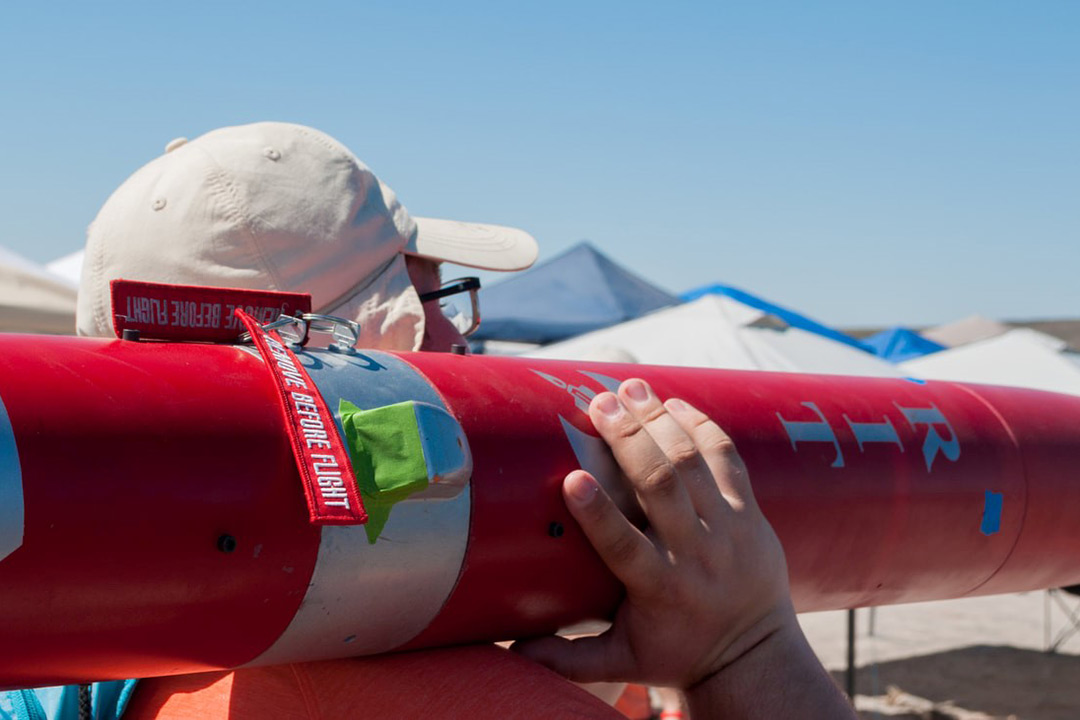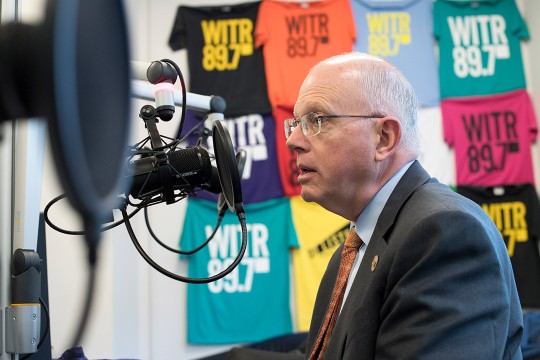Student rocket soars nearly 10,000 feet in first international competition
RIT Launch Initiative sets its sights on improving technology and career opportunities in space industry
RIT Launch Initiative placed first for flight performance and 11th overall in the Spaceport America Cup, the best outing for the team in just its third year of competitions.
RIT Launch Initiative placed first for flight performance and 11th overall in the Spaceport America Cup, the best outing for the team in just its third year of competitions.
RIT was one of 100-plus universities from around the world competing in the Intercollegiate Rocket Engineering Competition (IREC) in New Mexico—the collegiate rocketing community’s Frozen Four or March Madness. The team’s L3 high-powered rocket soared 9,990 feet, the closest and most accurate altitude in the competition under the 10,000-ft. category. RIT’s rocketeers—undergraduate students who build rockets that resemble those used for satellite and space launches—also won separate awards for proficiency, safety protocols and procedures.
“What makes it important is this was our first year competing in Spaceport America, and we placed within the top 10 percent of schools. It was pretty amazing,” said Ozzy Castillo, a team leader and RIT mechanical engineering undergraduate.
The RIT Launch Initiative is a multidisciplinary student organization that designs and manufactures rocket technologies for research and competitions as a way to prepare students for careers in aerospace. There has been an increased interest at RIT in space technologies over the past several years, and organizations like the Launch Initiative have soared on campus—led by students with an interest in the field, and supported by faculty who help guide projects, preparation for competitions and research connections with professionals in the aerospace industry.
Founded in 2015, the group is sponsored by the Kate Gleason College of Engineering and is located in The Construct, a student maker-space on campus. Rocket development takes nearly a year from planning to testing and competition launches. Starting in the fall semester, the group combines building competition rockets with orienting new members to different roles on the team.
“We are getting better and faster at building these,” said Castillo, a fifth-year student from the Bronx, N.Y. “This year with multiple teams, we have a project manager who oversees all the project leaders. And there are team officers, people with the most experience in simulations, or aero, to draw from their technical expertise. And for training new members, we have the L1 program.”
L1 is one of three levels of competitive, high powered rockets. Competitive events are sanctioned by the National Association of Rocketry, a nonprofit professional organization that provides insurance, laws and policies to manage the rocketry community around the country. Teams must build, test, launch, recover and reuse a rocket, under the guidance of an experienced and licensed rocketeer to attain certification.
Competition rockets can be 10-12 feet in height and need a large launch facility. The team has built relationships with other rocket enthusiast groups such as the Upstate Launch Group and MARS, both located south of campus, where they test launch rocket prototypes. (Test flights of student-designed rockets have to be launched off the RIT campus as the university is in the flight path of the Greater Rochester International Airport.)
“For the IREC competition, rockets were required to have a payload. Who better to have one made than SPEX?” said Castillo. SPEX is another RIT aerospace student organizations known best for building CubeSats and its annual high altitude balloon launch at the Imagine RIT: Creativity and Innovation Festival. “We delivered a rocket, and they delivered a payload. We had to deploy a payload and recover it separately; no one else did that. We were the only team that did that and it deployed successfully.”
The custom-built engine and payload projects are complicated, but through team work, projects in RIT’s multidisciplinary senior design program and faculty-researchers’ support, the altitude might only be surpassed by the students’ positive attitude, said Mike Buffalin, academic adviser and director of The Construct.
“They are looking to expand their range of projects, but also intend on increasing the aerospace influence at RIT, and bring the university to the forefront of this field. I think they can do it,” Buffalin said.
One of the goals for the next year is to design and manufacture a rocket that weighs close to 150 pounds and is capable of reaching 30,000 feet—they’d be one of the first collegiate-designed rockets to reach this altitude. It is a complicated project, and the team will be working with SPEX as well as looking to alumni in companies such as Blue Origin, SpaceX and Moog, talking to design engineers to discuss ideas.
“All these companies are looking to rocketry teams around the country,” said Castillo. “The space race is booming as you can see, there is such high demand for it. That alone will attract students to our organization.”
 Joseph Even, left, Jared Bandru, Ozzy Castillo and Jim Hearney, members of the RIT Launch Initiative, talk about their opening season and a big win at the international Intercollegiate Rocket Engineering Competition. Michelle Cometa
Joseph Even, left, Jared Bandru, Ozzy Castillo and Jim Hearney, members of the RIT Launch Initiative, talk about their opening season and a big win at the international Intercollegiate Rocket Engineering Competition. Michelle Cometa













